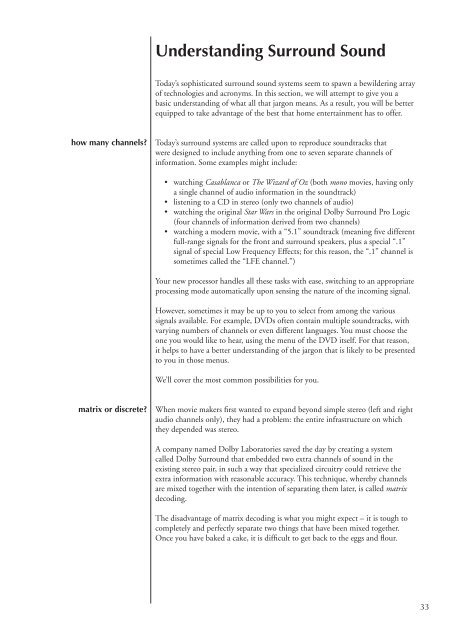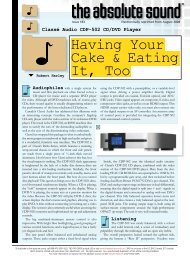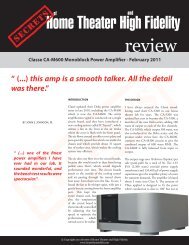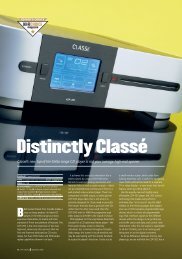Owner's Manual SSP-600 Surround Processor - Classé Audio
Owner's Manual SSP-600 Surround Processor - Classé Audio
Owner's Manual SSP-600 Surround Processor - Classé Audio
You also want an ePaper? Increase the reach of your titles
YUMPU automatically turns print PDFs into web optimized ePapers that Google loves.
Understanding <strong>Surround</strong> Sound<br />
Today’s sophisticated surround sound systems seem to spawn a bewildering array<br />
of technologies and acronyms. In this section, we will attempt to give you a<br />
basic understanding of what all that jargon means. As a result, you will be better<br />
equipped to take advantage of the best that home entertainment has to offer.<br />
how many channels?<br />
Today’s surround systems are called upon to reproduce soundtracks that<br />
were designed to include anything from one to seven separate channels of<br />
information. Some examples might include:<br />
• watching Casablanca or The Wizard of Oz (both mono movies, having only<br />
a single channel of audio information in the soundtrack)<br />
• listening to a CD in stereo (only two channels of audio)<br />
• watching the original Star Wars in the original Dolby <strong>Surround</strong> Pro Logic<br />
(four channels of information derived from two channels)<br />
• watching a modern movie, with a “5.1” soundtrack (meaning five different<br />
full-range signals for the front and surround speakers, plus a special “.1”<br />
signal of special Low Frequency Effects; for this reason, the “.1” channel is<br />
sometimes called the “LFE channel.”)<br />
Your new processor handles all these tasks with ease, switching to an appropriate<br />
processing mode automatically upon sensing the nature of the incoming signal.<br />
However, sometimes it may be up to you to select from among the various<br />
signals available. For example, DVDs often contain multiple soundtracks, with<br />
varying numbers of channels or even different languages. You must choose the<br />
one you would like to hear, using the menu of the DVD itself. For that reason,<br />
it helps to have a better understanding of the jargon that is likely to be presented<br />
to you in those menus.<br />
We’ll cover the most common possibilities for you.<br />
matrix or discrete?<br />
When movie makers first wanted to expand beyond simple stereo (left and right<br />
audio channels only), they had a problem: the entire infrastructure on which<br />
they depended was stereo.<br />
A company named Dolby Laboratories saved the day by creating a system<br />
called Dolby <strong>Surround</strong> that embedded two extra channels of sound in the<br />
existing stereo pair, in such a way that specialized circuitry could retrieve the<br />
extra information with reasonable accuracy. This technique, whereby channels<br />
are mixed together with the intention of separating them later, is called matrix<br />
decoding.<br />
The disadvantage of matrix decoding is what you might expect – it is tough to<br />
completely and perfectly separate two things that have been mixed together.<br />
Once you have baked a cake, it is difficult to get back to the eggs and flour.<br />
33
















